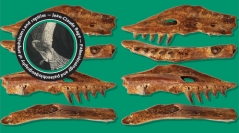

 Comptes Rendus Palevol
21 (25) - Pages 511-529
Comptes Rendus Palevol
21 (25) - Pages 511-529Saniwa is an extinct genus of varanid squamate from the Eocene of North America and Europe. Up to now, only one poorly known species, Saniwa orsmaelensis Dollo, 1923, has been reported from Europe. Diagnostic material was limited to vertebrae with only preliminary description and no figure provided, except of one dorsal vertebra that was designated as the lectotype. New specimens from the earliest Eocene of Dormaal, Belgium and Le Quesnoy, France, including recently recovered skull material, are described and illustrated here. These fossils representing the oldest varanid squamate allow further comparisons with the type species, Saniwa ensidens Leidy, 1870, from the early and middle Eocene of North America and to propose a new diagnosis for S. orsmaelensis. Its arrival in Europe is probably linked to rapid environmental changes around the Paleocene Eocene Thermal Maximum (PETM). The occurrence of S. orsmaelensis is restricted to the early Eocene of northwest Europe and paleogeographic considerations regarding the distribution of the genus Saniwa Leidy, 1870 suggest an Asian origin, but an African origin cannot be completely excluded.
Eocene, Europe, Dormaal, Varanidae, Saniwa